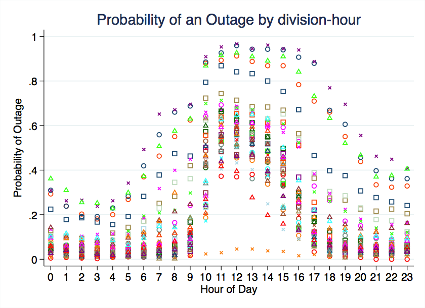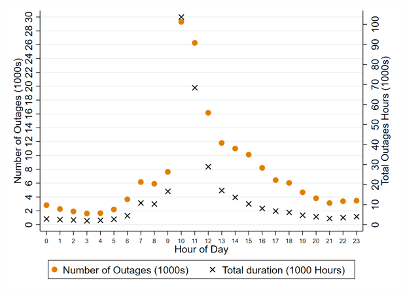The global population without electricity access (overwhelmingly located in Sub-Saharan Africa and Asia) fell below 1 billion in 2018. But this have-or-have-not measure of access to electricity overlooks how much electricity people actually consume and how reliable the supply is (see more here by Todd Moss).1 Power outages are widespread in growing economies, making electricity unreliable — even for those with ‘access.’ In addition to disrupting lives and hindering economic activity, outages indirectly cause air pollution issues.2,3
Back-Up Generators: a solution that creates more problems?
During power outages, many firms and households turn to back-up diesel generators. This causes an increase in pollutants including nitrogen oxide and particulate matter. These outage-induced emissions in the local atmosphere negatively impact health, school absences and labor supply, meaning outages have major economic and social consequences beyond direct production losses.
Outages and Pollution in Delhi
- Delhi (pop. ~20 mil.) experiences frequent power outages. Outages vary across Delhi — different areas experience significantly different levels of reliability (Figure 1), and are longest and most frequent around midday, coinciding with high demand due to working hours and rising temperatures (Figure 2).
- Delhi is also one of the most polluted cities in the world.4 Power outages contribute to this pollution when firms and households resort to back-up generators during power failures, emitting harmful toxins that affect millions of people.
Regulatory Solutions
In response, Delhi’s government has enacted multiple policies, including:
- Banning Diesel Generators. Diesel back-up generators are banned during high pollution months.5 However, this ban exposes firms to the disruptive effects of outages on social and economic activities. Low or zero emitting solutions such as solar technologies and inverters might be useful for small customers, but not for industrial users.
- Imposing Penalties on Distribution Companies. In 2017 the Delhi Electricity Regulatory Commission introduced a penalty scheme for outages requiring distribution companies to:
- Restore power within 1 hour
- Compensate Rs. 50/customer for the first two hours
- At the third hour, increase compensation to Rs. 100/customer
This incentivizes electricity providers to reduce outages by conducting regular maintenance and improving supply reliability, revenue collection and financial stability.6 IT solutions that provide real-time outage information such as Automatic Meter Reading and Advanced Metering Infrastructure help distribution companies react quickly to interruptions in supply. With sufficient incentives (or penalties) from regulators, distribution companies benefit from investing in these technologies to help reduce endemic outages.
Conclusion
This highlights the importance of investment in reliable power systems that don’t require back-up in the first place, and provides an example of how, with sufficient incentives, electric utilities will adopt technologies that improve reliability. Fortunately, policymakers are increasingly shifting away from a binary access definition to consider measures including reliability (e.g. World Bank’s Multi-Tier Framework, Energy for Growth Hub’s RACE metric). Such measures are needed to design policies that can achieve real universal access to electricity while minimizing damages to human health and the environment.
FIGURE 1: Probability of an outage by distribution area and hour of day.

Source: Authors’ calculations.
FIGURE 2: Number of outage events and number of outage hours by hour of day.

Source: Authors’ calculations.
Endnotes
- Cozzi, L., Chen, O., Daly, H., and Koh, A. “Population without access to electricity falls below 1 billion.” IEA. October 30, 2018.
- Gertler, P. J., Lee, K., & Mobarak, A. M. (2017). Electricity reliability and economic development in cities: A microeconomic perspective.
- Lee, K., Miguel, E., & Wolfram, C. (2017). Electrification and economic development: A microeconomic perspective.
- 16.8 million in the 2011 population census, projections for 2021 are around 21 million.
- There are certain exemptions such as hospitals and telecom towers.
- McRae, S. (2015). Infrastructure quality and the subsidy trap. American Economic Review, 105(1), 35-66.
